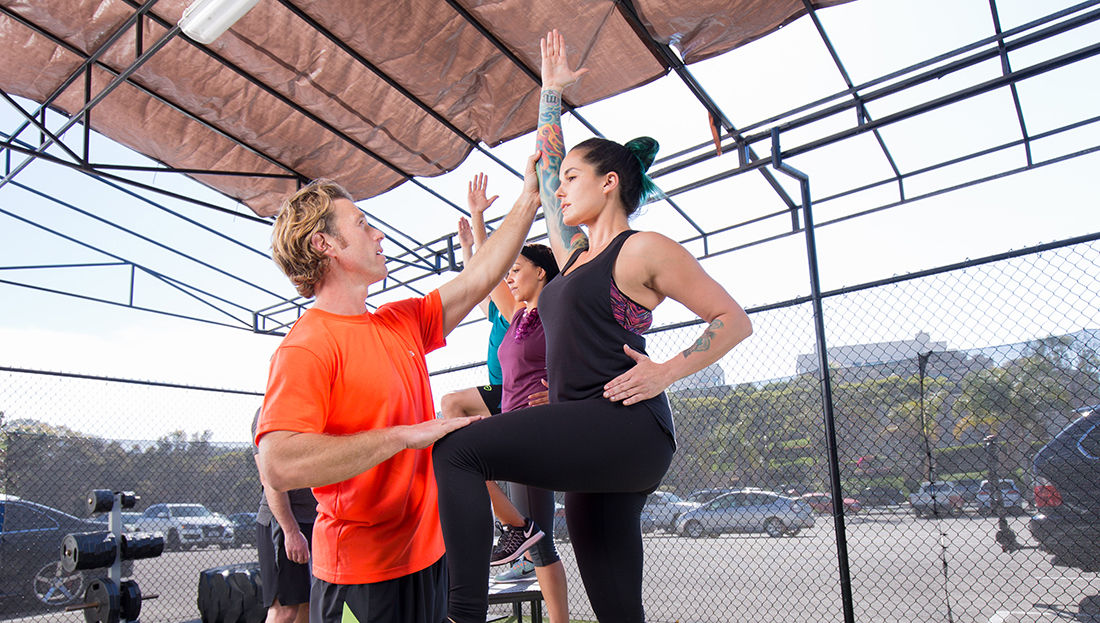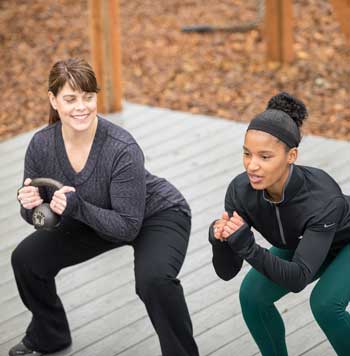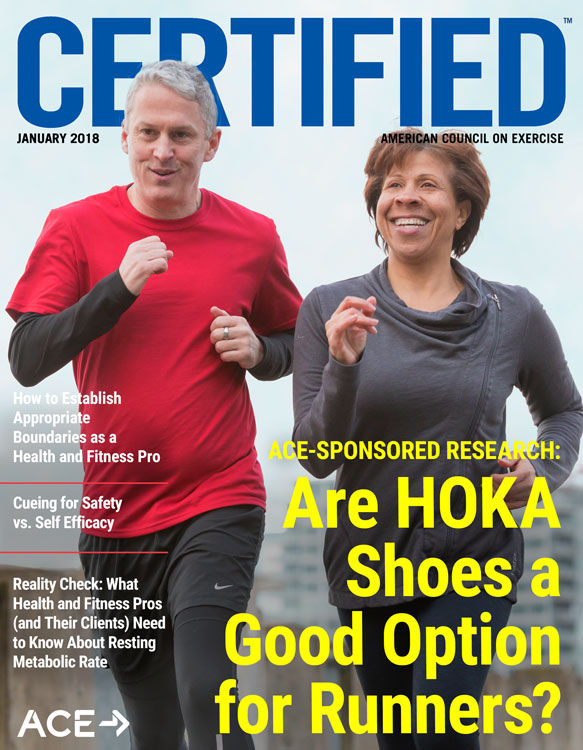
How many times have you been told, “Oh, I could never do a cycling class. That’s way too hard for me,” or “I wouldn’t make it through your boot camp!”?
When people lack confidence in their movement capabilities, the group fitness setting can be an intimidating place. As someone who loves to exercise, this may seem foreign to you, but consider how new participants joining your class for the first time might feel. They step into a room full of strangers and are asked to perform complex, unfamiliar and challenging movements. When you combine the rigors of a new class with low confidence in one’s physical abilities, the likelihood that these new participants will return to class is probably very low.
As a health and fitness professional, one of your most important jobs is keeping your clients and participants safe and helping them develop proper exercise form. However, well-intentioned cues could potentially cause more harm than good. When offering safety and form cues, it is possible to inadvertently worsen participants’ confidence in their ability to perform the exercises and create more anxiety with movement.
With new (and even seasoned) exercisers, self-efficacy is a vital component of enhancing exercise enjoyment and adherence. According to the social cognitive theory of behavior, self-efficacy is an individual’s belief in his or her ability to master a certain skill. High levels of self-efficacy increase the likelihood of continuing a behavior (e.g., exercise), whereas low levels are linked to avoidance of a behavior. In fact, a significant body of research suggests that self-efficacy is highly related to exercise adherence across a wide range of populations (Kroll et al., 2012; Strauss et al., 2001; McAuley and Jacobson, 1991).
Obviously, you can’t ignore form deviations and potentially unsafe situations in the name of enhanced self-efficacy. Rather, consider using the following strategies to enhance participants’ perceptions of their own abilities, while also ensuring you are providing them with safe and effective classes and workouts.
Consider Your Cueing
The terminology we use when cueing an exercise affects participants’ beliefs about their capabilities.
“I make sure to frame things in a positive rather than negative way [when cueing], which not only helps people feel better about themselves, but their brains are more receptive to the feedback,” says Liana Tsirklin, M.S., a health coach and group fitness instructor. “When we say something like, ‘Don't let your chest fall forward’ during a squat, the client may not hear the ‘don’t,’ and instead hears, ‘Let your chest fall forward,’ exacerbating the issue.”
 Instead, says Tsirklin, use a positive cue that promotes positive form, such as “Keep your chest up.” This type of cue has the dual effect of promoting proper form without highlighting that the participant is doing something wrong. Following up on form corrections once the client has made adjustments with a simple “Great correction!” or “Excellent job!” can reinforce learning and improve exercise-related confidence.
Instead, says Tsirklin, use a positive cue that promotes positive form, such as “Keep your chest up.” This type of cue has the dual effect of promoting proper form without highlighting that the participant is doing something wrong. Following up on form corrections once the client has made adjustments with a simple “Great correction!” or “Excellent job!” can reinforce learning and improve exercise-related confidence.
Helping participants feel form corrections can deepen their understanding of proper movement patterns.
“After correcting form, I like to make sure participants feel the exercise differently,” says Angel Chelik, M.S., owner of WorkBetter Wellness. “I’ll usually say something like, ‘Don’t you feel your triceps working more now?’ This not only encourages proper form, it also allows the client to feel the successful mastery of the move physically.”
Chelik also uses shout-outs to highlight proper form in her classes. “This kills several birds with one stone,” she says. “It reiterates biomechanics to all and gives the participant a boost of confidence for doing it right, which encourages him or her to continue.”
It can be tempting to correct every deviation seen in class in an effort to keep participants safe. However, this not only weakens exercise self-efficacy, but can also cause information overload, making it more challenging for individuals to interpret and execute form cues.
“I usually give people a 20% leeway, so if they’re within 80 to 100% of good form, I don’t see the need to address it right away,” says Ryan Halvorson, a fitness writer and personal trainer in San Diego, Calif. While major deviations require urgent attention, others that don’t pose an immediate risk are likely best left for after class.
Bottom line: Form corrections are essential to providing a safe group fitness class, but by carefully considering your delivery you can enhance participant safety and boost self-efficacy.
Construct Opportunities for Mastery Experience
A key component to building self-efficacy is experiencing feelings of mastery. Mastery occurs when individuals begin with less-challenging tasks and progress to completing more difficult tasks over time. While this is somewhat of a no-brainer when considering teaching safe exercises, it’s also a great strategy for enhancing self-efficacy.
“The best way to promote self-efficacy is to program so no one can fail,” says Shannon Fable, international fitness presenter and program developer. “Of course, that seems like a far too simple solution, but I caution instructors [to remember] that we tend to get bored with our material long before anyone else does. [So we] change for the sake of changing, add embellishments to exercises that are unnecessary or try to cram too much into a one-hour class to keep things moving,” she says. A better approach, explains Fable, is to “Start first by stripping down your class to the most essential elements, choose the best exercises, and concentrate on your coaching.”
Halvorson allows for mastery experience by creating classes on four-week intervals. “The first week is about learning the workout and movements. In subsequent weeks, the participants work to build on the first week’s foundation—whether that's adding repetitions, resistance, time on the clock or some other variable for improvement,” he says. “Or, it might be about gaining improved confidence with the exercise and feeling more comfortable with it. At the end of the four weeks they will likely have progressed and mastered the exercises and workout.”
This model reiterates the importance of starting with foundational movements when teaching exercises to the class. You may feel pressure to provide the most challenging class possible and skip right to more advanced options to ensure exercisers really “feel the burn.” That approach, however, both limits participants’ ability to experience feelings of mastery and increases their likelihood of experiencing an injury.
Encourage Autonomy
As a health and fitness professional, it’s tempting to consider yourself the captain of the ship when delivering your fitness classes. However, you can empower participants by giving them some control of the exercise experience.
“I regularly emphasize to participants that they are 100% in control of their workouts,” says Halvorson. “We take time to assess how the body and mind are feeling on a given day and then determine what type of effort is best. Autonomy is a key factor in building exercise confidence.”
Beyond choosing their individual exertion levels, giving participants a voice in exercise selection allows them to feel a sense of ownership in their workout experience.
“I offer a variety of movement options for each exercise and invite participants to attempt the one that resonates with them the most,” explains Halvorson. “I also don’t use any terminology that assigns a grade, such as easy, moderate or hard, for example. Someone may excel at squats and self-select the ‘hard’ option, but choose the ‘easy’ one for a pushing exercise because they're not as strong with pushing motions.” This strategy keeps clients from pigeonholing themselves into a weaker category because they struggle with certain exercises and allows them to explore a variety of movements and intensity levels.
Another way to encourage client autonomy is through self-selected exercise intensity. It’s impossible to know the conditioning level and movement capabilities of each participant in class, so this method gives participants space to make wise choices given their physical capabilities and needs.
“I invite participants to rest when they feel it’s necessary instead of waiting for me to tell them when to take a break,” Halvorson says. “I offer guidelines for rest. For instance, I tell them if they feel breathless or movement quality suffers, it could be time for a break. I’ve found this boosts confidence and lowers injury rates.”
Don’t be surprised if class participants find this unusual and difficult to do at first. “People are so used to relinquishing control to the instructor, this often requires practice for new participants,” says Halvorson.
“Autonomy comes from choice,” Fable says. “Instructors need to be less ‘follow the leader’ and more ‘find your own way.’” By giving participants power over their exercise selection and intensity, you can increase their confidence while creating a safe exercise experience.
Opportunities to Thrive
With effective cueing, enhanced participant autonomy and chances to experience feelings of mastery, group fitness classes are the perfect setting to improve exercise-related self-efficacy.
“Instructors need to think of themselves as more of a facilitator and less of a dictator,” argues Fable. “A big part of our job is empowerment.” By boosting the self-efficacy of those in your classes, you do more than deliver a killer workout. You play a powerful role in helping your participants become movers for life.
References
Kroll, T. et al. (2012). Perceived exercise self-efficacy as a predictor of exercise behavior in individuals aging with spinal cord injury. American Journal of Physical Medicine and Rehabilitation, 91, 8, 640–651.
McAuley, E. and Jacobson, L. (1991). Self-efficacy and exercise participation in sedentary adult females. American Journal of Health Promotion, 5, 3, 185–207.
Strauss, R.S. et al. (2001). Psychosocial correlates of physical activity in healthy children. Archives of Pediatrics and Adolescent Medicine, 155, 8, 897–902.

 by
by 

 Instead, says Tsirklin, use a positive cue that promotes positive form, such as “Keep your chest up.” This type of cue has the dual effect of promoting proper form without highlighting that the participant is doing something wrong. Following up on form corrections once the client has made adjustments with a simple “Great correction!” or “Excellent job!” can reinforce learning and improve exercise-related confidence.
Instead, says Tsirklin, use a positive cue that promotes positive form, such as “Keep your chest up.” This type of cue has the dual effect of promoting proper form without highlighting that the participant is doing something wrong. Following up on form corrections once the client has made adjustments with a simple “Great correction!” or “Excellent job!” can reinforce learning and improve exercise-related confidence.
